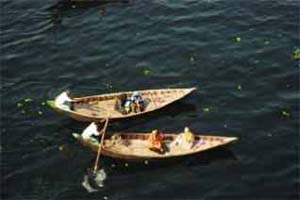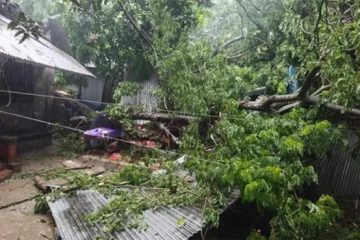 Millions of residents in Old Town of Dhaka are exposed to serious health risks such as cancer through the water supplied to them by the Water Supply and Sewerage Authority, according to experts.
Millions of residents in Old Town of Dhaka are exposed to serious health risks such as cancer through the water supplied to them by the Water Supply and Sewerage Authority, according to experts.
The water used by many living in Old Town comes from the River Buriganga and is treated at the Chandnighat Water Treatment Plant, installed in 1874, which experts say is not equipped to treat the highly contaminated water containing untreated chemical wastes and other kinds of sewage.
Public health experts also claim that the presence of toxic heavy metals in the drinking water may cause cancer.
The first water treatment plant installed at Chandnighat during the British period still supplies 3.9 crore litres of ‘drinking’ water to the densely populated areas of Chandnighat, Sowarighat, Sadarghat, Begum Bazar, Mitford, Postagala, Islambagh, Lalbagh, Chawkbazar and other areas under the Lalbagh and Kotwali police stations.
The plant uses alum, chlorine, bleaching power and a coagulant to treat the water which experts say is not adequate to deal with heavy metals present in the water.
The plant was last renovated in 1997 resulting in an increase in the amount of water that could be treated,
A routine monthly test carried out by the Department of Environment at Chandighat in March 2011 indicates that highly contaminated Buriganga is ‘biologically dead.’
The dissolved oxygen in the river water is only 0.14 mg/litre when the acceptable level is 5 mg/litre, about 36 times the current level, it found.
The tests also found a high rate of both organic and toxic chemicals. It found that the chemical oxygen demand (COD) level was 120 mg/litre against the permitted level of 6 mg/litre and biochemical oxygen demand (BOD) was 46 mg/litre, which is around 15 times higher than the permitted limit of 3 milligrams per litre.
‘The dissolved chromium and other toxic heavy metals found in the Buriganga cannot be treated through the conventional treatment method used in the Chandnighat water treatment plant,’ Professor Mujibur Rahman, a teacher of environmental engineering at Bangladesh University of Engineering and Technology told New Age.
‘WASA must test the heavy metal and other chronic parameters in the treated water that is supplied to the consumers and make the reports public,’ he added.
Professor Kazi Matin U Ahmed, a teacher of geology at Dhaka University, also told New Age, ‘Even the water extracted through the deep tube wells of Dhaka WASA adjacent to the River Buriganga must be tested as toxic metals have been found in the underground water near the Hazaribagh tanneries.’
He was referring to an area of a 2006 study, undertaken by two local and two foreign hydro-geologists, which found high levels of chromium and lead in shallow groundwater (10–20m below surface) in Hazaribagh.
Health experts warn that the high level of heavy metals and industrial wastes in drinking water and the high level of chlorine used to treat that water during dry seasons impose serious risks to consumer health involving their kidneys, livers, lungs, and stomach.
‘Intake of dissolved heavy metals like chromium, cadmium, mercury and others with drinking water create neuro-chronic effect in the human body and can destroy antibodies,’ Professor ABM Faroque of pharmaceutical technology at Dhaka University, told New Age.
‘As such heavy metals accumulate in human body, they can damage the kidney, heart, liver and other vital organs,’ he added.
He also said that these toxic chemicals can cause cancer.
A senior Dhaka WASA official admitted to New Age that authorities had never tested for any toxic chemicals in the treated water, saying that they only test for colour, acidity, cloudiness, level of chlorine and dissolved solids.
‘I do not know whether heavy metals can be found in dissolved form in water. We use a coagulant called Cat Flog for sedimentation of the un-dissolved heavy metals in the treatment plant to separate them from the supplied water,’ M Liaquat Ali, deputy managing director (research, planning, development) of Dhaka WASA, told New Age.
‘There be may a small amount of heavy metals in the treated water. I do not believe it is at a level to create risks. To improve the quality of the treated water, we add water from the deep tube wells installed in the treatment plant,’ he added.
Asked about the situation with dissolved heavy metals, he admitted that the treatment plant had no system to remove them and that he did not know how high their levels were in the treated water.
Mujibur Rahman was also doubtful about whether the treatment plant was capable of removing all the un-dissolved heavy metals as the levels in the river were so high.
Commissioned by the World Bank and WASA, the Institute of Water Modelling has carried out a variety of tests on Dhaka’s river water quality in the last decade.
The tests showed not only very low levels of dissolved oxygen, and high levels of bio-degradable organic pollutant in the Turag-Buriganga river system but also levels of other chemicals including ammonia and heavy metals such as aluminium, cadmium, lead, mercury, along with sulphates, said SM Mahbubur Rahman, principal specialist and director of the Water Resource Planning Division of the institute.
A World Bank’s unpublished 2008 report, citing a United Nations Industrial Development Organisation’s (Unido) study, mentions that the chrome — contained in sludge and solid waste, especially wastes that is generated by the tanneries at Hazaribagh — is highly contaminating the Buriganga and its surrounding areas.
Geologists have also found hazardous heavy metals at high levels in the in the groundwater in the area.
There are small shipyards, dyeing units and small industries on both sides of the Buriganga between the Bangladesh-China Friendship Bridge 1 and 2, at Babubazar, Jinjira, Kaliganj, Postagola and Shyampur that discharge untreated washing and clinical wastes, used batteries, plastic bottles and containers, and other discarded plastic materials and burnt oil into the river water.
They also dump the useless solid wastes of crushed materials into the river.
Courtesy of New Age




















